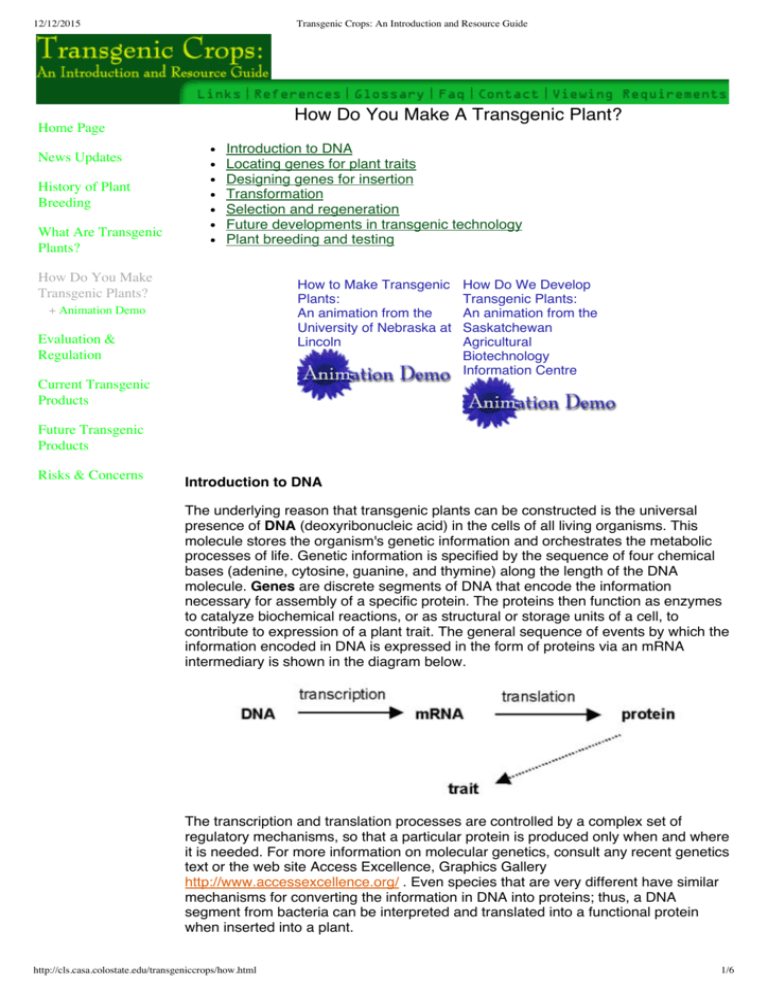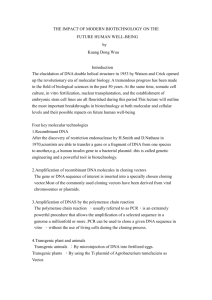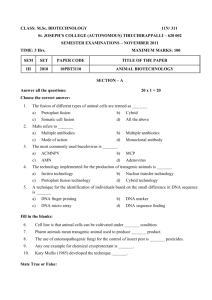
12/12/2015
Transgenic Crops: An Introduction and Resource Guide
How Do You Make A Transgenic Plant?
Home Page
News Updates
History of Plant
Breeding
What Are Transgenic
Plants?
Introduction to DNA
Locating genes for plant traits
Designing genes for insertion
Transformation
Selection and regeneration
Future developments in transgenic technology
Plant breeding and testing
How Do You Make
Transgenic Plants?
+ Animation Demo
How to Make Transgenic
Plants:
An animation from the
University of Nebraska at
Lincoln
Evaluation &
Regulation
How Do We Develop
Transgenic Plants:
An animation from the
Saskatchewan
Agricultural
Biotechnology
Information Centre
Current Transgenic
Products
Future Transgenic
Products
Risks & Concerns
Introduction to DNA
The underlying reason that transgenic plants can be constructed is the universal
presence of DNA (deoxyribonucleic acid) in the cells of all living organisms. This
molecule stores the organism's genetic information and orchestrates the metabolic
processes of life. Genetic information is specified by the sequence of four chemical
bases (adenine, cytosine, guanine, and thymine) along the length of the DNA
molecule. Genes are discrete segments of DNA that encode the information
necessary for assembly of a specific protein. The proteins then function as enzymes
to catalyze biochemical reactions, or as structural or storage units of a cell, to
contribute to expression of a plant trait. The general sequence of events by which the
information encoded in DNA is expressed in the form of proteins via an mRNA
intermediary is shown in the diagram below.
The transcription and translation processes are controlled by a complex set of
regulatory mechanisms, so that a particular protein is produced only when and where
it is needed. For more information on molecular genetics, consult any recent genetics
text or the web site Access Excellence, Graphics Gallery
http://www.accessexcellence.org/ . Even species that are very different have similar
mechanisms for converting the information in DNA into proteins; thus, a DNA
segment from bacteria can be interpreted and translated into a functional protein
when inserted into a plant.
http://cls.casa.colostate.edu/transgeniccrops/how.html
1/6
12/12/2015
Transgenic Crops: An Introduction and Resource Guide
Among the most important tools in the genetic
engineer's tool kit are enzymes that perform
specific functions on DNA. The image at left
(Voet, Donald 1995 Biochemistry) shows the
structure of DNA as a double helix with the
phosphate backbone in yellow-green and the
bases in white or teal green. The blue and red
figures represent the 3-D structure of a
restriction enzyme (EcoR1) which recognizes
and cuts the DNA at a specific region of the
DNA. Other enzymes known as ligases join the
ends of two DNA fragments. These and other
enzymes enable the manipulation and
amplification of DNA, essential components in
joining the DNA of two unrelated organisms.
[Top]
Locating Genes for Plant Traits
Identifying and locating genes for agriculturally important traits is currently the most
limiting step in the transgenic process. We still know relatively little about the specific
genes required to enhance yield potential, improve stress tolerance, modify chemical
properties of the harvested product, or otherwise affect plant characters. Usually,
identifying a single gene involved with a trait is not sufficient; scientists must
understand how the gene is regulated, what other effects it might have on the plant,
and how it interacts with other genes active in the same biochemical pathway. Public
and private research programs are investing heavily into new technologies to rapidly
sequence and determine functions of genes of the most important crop species.
These efforts should result in identification of a large number of genes potentially
useful for producing transgenic varieties.
The techniques for locating and sequencing stretches of DNA that control specific
traits are beyond the scope of this web site. The interested reader is referred to Klug
and Cummings, 1998, Lewin, 1999; Wong, 1997, or other recent genetics texts.
[Top]
Designing Genes for Insertion
Once a gene has been isolated and cloned (amplified in a bacterial vector), it must
undergo several modifications before it can be effectively inserted into a plant.
Simplified representation of a constructed transgene, containing necessary components for
successful integration and expression.
1. A promoter sequence must be added for the gene to be correctly expressed
(i.e., translated into a protein product). The promoter is the on/off switch that
controls when and where in the plant the gene will be expressed. To date,
most promoters in transgenic crop varieties have been "constitutive", i.e.,
causing gene expression throughout the life cycle of the plant in most tissues.
The most commonly used constitutive promoter is CaMV35S, from the
http://cls.casa.colostate.edu/transgeniccrops/how.html
2/6
12/12/2015
Transgenic Crops: An Introduction and Resource Guide
cauliflower mosaic virus, which generally results in a high degree of expression
in plants. Other promoters are more specific and respond to cues in the plant's
internal or external environment. An example of a light-inducible promoter is
the promoter from the cab gene, encoding the major chlorophyll a/b binding
protein.
2. Sometimes, the cloned gene is modified to achieve greater expression in a
plant. For example, the Bt gene for insect resistance is of bacterial origin and
has a higher percentage of A-T nucleotide pairs compared to plants, which
prefer G-C nucleotide pairs. In a clever modification, researchers substituted
A-T nucleotides with G-C nucleotides in the Bt gene without significantly
changing the amino acid sequence. The result was enhanced production of the
gene product in plant cells.
3. The termination sequence signals to the cellular machinery that the end of
the gene sequence has been reached.
4. A selectable marker gene is added to the gene "construct" in order to identify
plant cells or tissues that have successfully integrated the transgene. This is
necessary because achieving incorporation and expression of transgenes in
plant cells is a rare event, occurring in just a few percent of the targeted
tissues or cells. Selectable marker genes encode proteins that provide
resistance to agents that are normally toxic to plants, such as antibiotics or
herbicides. As explained below, only plant cells that have integrated the
selectable marker gene will survive when grown on a medium containing the
appropriate antibiotic or herbicide. As for other inserted genes, marker genes
also require promoter and termination sequences for proper function.
[Top]
Transforming Plants
Transformation is the heritable change in a cell or organism brought about by the
uptake and establishment of introduced DNA. There are two main methods of
transforming plant cells and tissues:
1. The "Gene Gun" method (also known as microprojectile bombardment or
biolistics). This technique, which is shown and explained in the animated demo
section of this web site, has been especially useful in transforming monocot
species like corn and rice.
2. The Agrobacterium method, which is described below. Transformation via
Agrobacterium has been successfully practiced in dicots (broadleaf plants like
soybeans and tomatoes) for many years, but only recently has it been effective
in monocots (grasses and their relatives). In general, the Agrobacterium
method is considered preferable to the gene gun, because of the greater
frequency of single-site insertions of the foreign DNA, making it easier to
monitor.
Agrobacterium Method of Plant Transformation
Agrobacterium tumefaciens is a remarkable species of soil-dwelling bacteria that has
the ability to infect plant cells with a piece of its DNA. When the bacterial DNA is
integrated into a plant chromosome, it effectively hijacks the plant's cellular
machinery and uses it to ensure the proliferation of the bacterial population. Many
gardeners and orchard owners are unfortunately familiar with A. tumefaciens,
because it causes crown gall diseases in many ornamental and fruit plants.
http://cls.casa.colostate.edu/transgeniccrops/how.html
3/6
12/12/2015
Transgenic Crops: An Introduction and Resource Guide
Crown gall of raspberry caused by Agrobacterium tumefaciens.
Source: Ohio State University
Diagram of Agrobacterium tumefaciens cell
The DNA in an A. tumefaciens cell is contained in the bacterial chromosome as well
as in another structure known as a Ti (tumor-inducing) plasmid. The Ti plasmid
contains
a stretch of DNA termed T-DNA (~20 kb long) that is transferred to the plant
cell in the infection process.
a series of vir (virulence) genes that direct the infection process.
A tumefaciens can only infect a plant through wounds. When a plant root or stem is
wounded it gives off certain chemical signals. In response to those signals, the vir
genes of A. tumefaciens become activated and direct a series of events necessary
for the transfer of the T-DNA from the Ti plasmid to the plant's chromosome. Different
vir genes
Copy the T-DNA.
Attach a product to the copied T-DNA strand to act as a leader.
Add proteins along the length of the T-DNA, possibly as a protective
mechanism.
Open a channel in the bacterial cell membrane, through which the T-DNA
passes.
The T-DNA then enters the plant cell through the wound. It is not clear how the
bacterial DNA moves from the cytoplasm to the nucleus of the plant cell, nor how the
T-DNA becomes integrated into the plant chromosome. Remember that most of the
time plant DNA does not exist as an exposed strand, but is wrapped with histone
proteins and is in a supercoiled state. One speculation is that the T-DNA waits until
the plant DNA is being replicated or transcribed, then inserts itself into the exposed
plant DNA (Galun and Breiman, 1997).
To harness A. tumefaciens as a transgene vector, scientists have removed the
tumor-inducing section of T-DNA, while retaining the T-DNA border regions and the
vir genes. The transgene is inserted between the T-DNA border regions, where it is
transferred to the plant cell and becomes integrated into the plant's chromosomes
http://cls.casa.colostate.edu/transgeniccrops/how.html
4/6
12/12/2015
Transgenic Crops: An Introduction and Resource Guide
(Wong, 1997).
[Top]
Selection and Regeneration
Selection of successfully transformed tissues. Following the gene insertion
process, plant tissues are transferred to a selective medium containing an antibiotic
or herbicide, depending on which selectable marker was used. Only plants
expressing the selectable marker gene will survive, as shown in the figure, and it is
assumed that these plants will also possess the transgene of interest. Thus,
subsequent steps in the process will only use these surviving plants.
When grown on selective media, only plant tissues that have successfully
integrated the transgene construct will survive.
Regeneration of whole plants. To obtain whole plants from transgenic tissues such
as immature embryos, they are grown under controlled environmental conditions in a
series of media containing nutrients and hormones, a process known as tissue
culture. Once whole plants are generated and produce seed, evaluation of the
progeny begins. This regeneration step has been a stumbling block in producing
transgenic plants in many species, but specific varieties of most crops can now be
transformed and regenerated.
Tissue culture of transgenic plants in a
controlled environmental chamber.
Source: USDA
[Top]
Future Developments in Transgenic Technology
New techniques for producing transgenic plants will improve the efficiency of the
process and will help resolve some of the environmental and health concerns.
Among the expected changes are the following:
http://cls.casa.colostate.edu/transgeniccrops/how.html
5/6
12/12/2015
Transgenic
Crops: An
Introduction
and Resource Guide
Among the expected
changes
are
the following:
More efficient transformation, that is, a higher percentage of plant cells will
successfully incorporate the transgene.
Better marker genes to replace the use of antibiotic resistance genes.
Better control of gene expression through more specific promoters, so that the
inserted gene will be active only when and where needed.
Transfer of multi-gene DNA fragments to modify more complex traits.
[Top]
Plant Breeding and Testing
Intrinsic to the production of transgenic plants is an extensive evaluation process to
verify whether the inserted gene has been stably incorporated without detrimental
effects to other plant functions, product quality, or the intended agroecosystem. Initial
evaluation includes attention to:
Activity of the introduced gene
Stable inheritance of the gene
Unintended effects on plant growth, yield, and quality
If a plant passes these tests, most likely it will not be used directly for crop
production, but will be crossed with improved varieties of the crop. This is because
only a few varieties of a given crop can be efficiently transformed, and these
generally do not possess all the producer and consumer qualities required of modern
cultivars. The initial cross to the improved variety must be followed by several cycles
of repeated crosses to the improved parent, a process known as backcrossing. The
goal is to recover as much of the improved parent's genome as possible, with the
addition of the transgene from the transformed parent.
The next step in the process is multi-location and multi-year evaluation trials in
greenhouse and field environments to test the effects of the transgene and overall
performance. This phase also includes evaluation of environmental effects and food
safety. For more information on these aspects, please proceed to the Evaluation &
Regulation portion of this web site.
[Top]
Ann Fenwick, formerly a research associate in the Department of Soil and
Crops Sciences at Colorado State University, contributed to the content on this
page.
Page last updated : March 11, 2004
© Copyright Department of Soil and Crop Sciences at Colorado State University, 1999-2004. All
Rights Reserved.
View CSU's copyright policy.
http://cls.casa.colostate.edu/transgeniccrops/how.html
6/6




![Instructions for BLAST [alublast]](http://s3.studylib.net/store/data/007906582_2-a3f8cf4aeaa62a4a55316a3a3e74e798-300x300.png)





